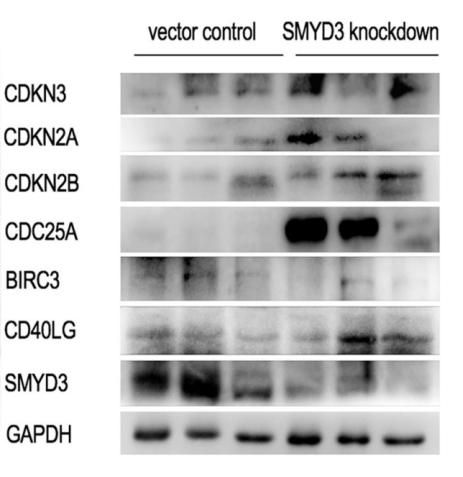CDK3 Antibody - #DF8911
| Product: | CDK3 Antibody |
| Catalog: | DF8911 |
| Description: | Rabbit polyclonal antibody to CDK3 |
| Application: | WB IF/ICC |
| Reactivity: | Human, Mouse |
| Prediction: | Pig, Bovine, Sheep, Rabbit |
| Mol.Wt.: | 35 kDa; 35kD(Calculated). |
| Uniprot: | Q00526 |
| RRID: | AB_2842107 |
Related Downloads
Protocols
Product Info
*The optimal dilutions should be determined by the end user.
*Tips:
WB: For western blot detection of denatured protein samples. IHC: For immunohistochemical detection of paraffin sections (IHC-p) or frozen sections (IHC-f) of tissue samples. IF/ICC: For immunofluorescence detection of cell samples. ELISA(peptide): For ELISA detection of antigenic peptide.
Cite Format: Affinity Biosciences Cat# DF8911, RRID:AB_2842107.
Fold/Unfold
Cdk 3; Cdk3; CDK3_HUMAN; CDKN3; Cell division kinase 3; Cell division protein kinase 3; Cyclin dependent kinase 3; Cyclin-dependent kinase 3; OTTHUMP00000206828; p36;
Immunogens
- Q00526 CDK3_HUMAN:
- Protein BLAST With
- NCBI/
- ExPASy/
- Uniprot
MDMFQKVEKIGEGTYGVVYKAKNRETGQLVALKKIRLDLEMEGVPSTAIREISLLKELKHPNIVRLLDVVHNERKLYLVFEFLSQDLKKYMDSTPGSELPLHLIKSYLFQLLQGVSFCHSHRVIHRDLKPQNLLINELGAIKLADFGLARAFGVPLRTYTHEVVTLWYRAPEILLGSKFYTTAVDIWSIGCIFAEMVTRKALFPGDSEIDQLFRIFRMLGTPSEDTWPGVTQLPDYKGSFPKWTRKGLEEIVPNLEPEGRDLLMQLLQYDPSQRITAKTALAHPYFSSPEPSPAARQYVLQRFRH
Predictions
Score>80(red) has high confidence and is suggested to be used for WB detection. *The prediction model is mainly based on the alignment of immunogen sequences, the results are for reference only, not as the basis of quality assurance.
High(score>80) Medium(80>score>50) Low(score<50) No confidence
PTMs - Q00526 As Substrate
| Site | PTM Type | Enzyme | Source |
|---|---|---|---|
| K9 | Ubiquitination | Uniprot | |
| T14 | Phosphorylation | Q00526 (CDK3) | Uniprot |
| Y15 | Phosphorylation | Q00526 (CDK3) | Uniprot |
| Y19 | Phosphorylation | Q00526 (CDK3) | Uniprot |
| K33 | Ubiquitination | Uniprot | |
| K59 | Ubiquitination | Uniprot | |
| T158 | Phosphorylation | Uniprot | |
| Y159 | Phosphorylation | Uniprot | |
| T160 | Phosphorylation | Q00526 (CDK3) | Uniprot |
| T198 | Phosphorylation | Uniprot | |
| S207 | Phosphorylation | Q00526 (CDK3) | Uniprot |
| Y236 | Phosphorylation | Uniprot | |
| S272 | Phosphorylation | Uniprot |
PTMs - Q00526 As Enzyme
| Substrate | Site | Source |
|---|---|---|
| P03372 (ESR1) | S104 | Uniprot |
| P03372 (ESR1) | S106 | Uniprot |
| P03372 (ESR1) | S118 | Uniprot |
| P05412 (JUN) | S63 | Uniprot |
| P05412 (JUN) | S73 | Uniprot |
| P06400 (RB1) | S807 | Uniprot |
| P06400 (RB1) | S811 | Uniprot |
| P18846 (ATF1) | S63 | Uniprot |
| P43629-1 (KIR3DL1) | S296 | Uniprot |
| Q00526 (CDK3) | T14 | Uniprot |
| Q00526 (CDK3) | Y15 | Uniprot |
| Q00526 (CDK3) | Y19 | Uniprot |
| Q00526 (CDK3) | T160 | Uniprot |
| Q00526 (CDK3) | S207 | Uniprot |
| Q12800 (TFCP2) | S309 | Uniprot |
| Q5TKA1 (LIN9) | T96 | Uniprot |
| Q8TDN4-2 (CABLES1) | S48 | Uniprot |
| Q8TDN4 (CABLES1) | S313 | Uniprot |
Research Backgrounds
Serine/threonine-protein kinase that plays a critical role in the control of the eukaryotic cell cycle; involved in G0-G1 and G1-S cell cycle transitions. Interacts with CCNC/cyclin-C during interphase. Phosphorylates histone H1, ATF1, RB1 and CABLES1. ATF1 phosphorylation triggers ATF1 transactivation and transcriptional activities, and promotes cell proliferation and transformation. CDK3/cyclin-C mediated RB1 phosphorylation is required for G0-G1 transition. Promotes G1-S transition probably by contributing to the activation of E2F1, E2F2 and E2F3 in a RB1-independent manner.
Expressed in cancer cell lines and glioblastoma tissue.
Interacts with CABLES1 and CABLES2 (By similarity). Interacts with ATF1. Binding to CCNC/cyclin-C promotes RB1 phosphorylation.
Belongs to the protein kinase superfamily. CMGC Ser/Thr protein kinase family. CDC2/CDKX subfamily.
References
Application: WB Species: mouse Sample: tumor
Application: WB Species: human Sample: H1299 cells
Restrictive clause
Affinity Biosciences tests all products strictly. Citations are provided as a resource for additional applications that have not been validated by Affinity Biosciences. Please choose the appropriate format for each application and consult Materials and Methods sections for additional details about the use of any product in these publications.
For Research Use Only.
Not for use in diagnostic or therapeutic procedures. Not for resale. Not for distribution without written consent. Affinity Biosciences will not be held responsible for patent infringement or other violations that may occur with the use of our products. Affinity Biosciences, Affinity Biosciences Logo and all other trademarks are the property of Affinity Biosciences LTD.


